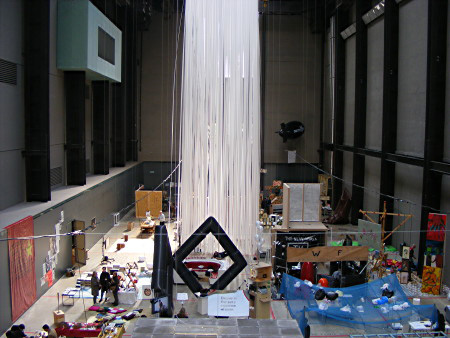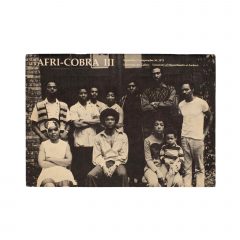In May of 2010 the Tate Modern staged No Soul For Sale, billed as a ‘Festival of Independents’ that was ‘neither a fair or an exhibition, [but] a convention of individuals and groups who devote their energies to art they believe in, beyond the limits of the market and other logistical constraints'(1). NSFS brought 70 artist collectives to Turbine Hall who exhibited alongside one another without partitions or walls. The organization of the non-fair was purportedly modeled after the set of Lars von Trier’s film Dogville(2), meaning that the non-exhibition space for each invited party was marked out on the floor. The quasi-convention was the second manifestation of NSFS–the first was hosted by X Initiative at the former Dia Art Foundation headquarters in Chelsea, New York in June of 2009.
The Tate Modern offered the invited orgs, collectives and etcs absolutely no compensation for setting up shop in Turbine Hall–but neither were the galleries charged to be a part of the proceedings. Many spaces accepted the Tate’s invitation as a great opportunity while at least one group of anonymous British artists and arts professionals called “Making a Living” issued an open letter that stated “The title No Soul For Sale re-enforces deeply reductive stereotypes about the artist and art production. With its romantic connotations of the soulful artist, who makes art from inner necessity without thought of recompense, No Soul For Sale implies that as artists we should expect to work for free and that it is acceptable to forgo the right to be paid for our labour.” Read the entire letter online here. Other groups, like W.A.G.E (Working Artist and the Greater Economy), participated in NSFS at X Initiative but drew the line at having a presence at NSFS at the Tate Modern.
This small protest was of course accepted by curator Cecilia Alemani as welcomed institutional critique (3) and perhaps mostly forgotten about in the nearly six months since NSFS took place. The issues raised by NSFS have a larger art-world relevance and set up an interesting conversation about the price and the value equated to diy arts establishments and what those stakes might mean to the creative economy. In order to explore these issues I have written two articles.
This article takes an against stance, arguing that artist and art organization should have protested NSFS and exhibitions like it, alternative spaces are alternative for the very fact that they operate outside the systems ascribed by the Tate–artists should be paid for the work that they do, especially by major institutions that have the resources to do so. Art is a skill that people are educated for and like all educated persons that render a useful service they should be paid.
The opposite argument–also by me, has been published in print in Machete. You may pick one up at Marginal Utility, located at 319 N 11th street (Philadelphia) on the 2nd floor, absolutely free of charge.
In this article we will explore what it might mean to set up a system in which cultural capital has an exchange rate of zero dollars.
Exhibit A:
An excerpt from a conversation with Nike Desis and Josh Kerner of FLUXspace. FLUXspace was invited to be a part of, and took part in, both incarnations of NSFS.
Annette Monnier: “I get it. No organization or project that I’ve ever been a part of would have ever said ‘no’ to being part of something at the Tate Modern. We would have gone, no matter what the tickets cost and paid the whole way ourselves. . . but when you’re a young artist going to art school you think that by the time you make it to the Tate Modern you are getting paid to be there. . . ”
Nike Desis: “That was my question, if we don’t get paid at the Tate Modern then when do we get paid?”
Josh Kerner: “I think you just answered your own question.”
AM: “That’s a little scary”
ND: “That is a little scary”
JK: “The economic situation that we’ve set up as an alternative art space is not an economic system that functions through monetary transfer. It functions through the transfer of time, generosity, and other things and that’s a system that WE, I believe, are responsible for. It’s one of those situations that if you’re going to point your finger at the Tate you’ve got to point four fingers back at yourself.”
*It is important to note that this is a excerpt from a half hour conversation in which both Nike and Josh expressed various views, both positive and negative, about the NSFS experience.
Exhibit B:
I sell my soul but at the highest rates
Closing Arguments
Those organizations that participated in NSFS should feel used, because they were. By hosting NSFS the Tate was made to look like a friendly and open environment that supported and in fact worked in tangent with alternative models. NSFS was not a conference put together so that fellow independent spaces could network together. Nowhere in the programming did time exist to do so. The Tate instead scheduled an art exhibition in which each alternative space was the art–only they were art that constantly had to work and perform for the public. This is very cheap programming that garners a lot of press. This is cheap programming instead of programming that someone should be getting reimbursed for.
Art is an important service provided to the public by skilled and trained individuals who are indeed special and who require reimbursement for services. Artists who work inside the system of established art institutions but work for free or very little sabotage an artist’s right to earn a living and create an environment where art is expected to be provided to the public free of charge. It is one thing for an artist to remove themselves entirely from capitalism and create an oeuvre that politically challenges the system of monetary exchange but it is quite another for an artist to work within the system and yet still not receive the benefits of doing so. If artists do not demand payment for their services they will not be paid and art will become a service that is always free.
Artists and artist-run spaces should band together and boycott situations like those set up by the Tate Modern for No Soul for Sale. This is not to say that festivals like No Soul for Sale should not take place, but they should be properly equipped and provided for when they do. Institutions like the Tate, large Institutions with enormous budgets and resources, must be held accountable for being the model of art-world practices.
Referenced in this text:
2. “Restoring the ‘Eek’ to Eking Out a Living” written by Holland Cotter and published in the New York Times on June 24, 2009
This article would not have been possible without valuable conversations with Andrew Suggs, Nike Desis, Josh Kerner and Angela Jeradi–all of whom were participants in No Soul for Sale.










